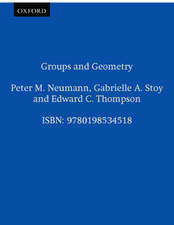Categories of Commutative Algebras
Autor Yves Diersen Limba Engleză Hardback – 4 iun 1992
Preț: 530.05 lei
Preț vechi: 799.32 lei
-34% Nou
Puncte Express: 795
Preț estimativ în valută:
101.42€ • 105.90$ • 83.75£
101.42€ • 105.90$ • 83.75£
Carte tipărită la comandă
Livrare economică 05-11 aprilie
Preluare comenzi: 021 569.72.76
Specificații
ISBN-13: 9780198535867
ISBN-10: 0198535864
Pagini: 280
Dimensiuni: 161 x 241 x 22 mm
Greutate: 0.62 kg
Ediția:New.
Editura: Clarendon Press
Colecția Clarendon Press
Locul publicării:Oxford, United Kingdom
ISBN-10: 0198535864
Pagini: 280
Dimensiuni: 161 x 241 x 22 mm
Greutate: 0.62 kg
Ediția:New.
Editura: Clarendon Press
Colecția Clarendon Press
Locul publicării:Oxford, United Kingdom
Cuprins
Introduction; Zariski categories; Classical objects; Spectra; Schemes; Jacobson ultraschemes; Algebraic varieties; Zariski toposes; Neat objects and morphisms; Flatness properties; Etale objects and morphisms; Terminators; Some constructions of Zariski categories.
Recenzii
'If you prefer your Zariski categories to be cosliced and your prelocal morphisms to be co-universal, or equivalently, interminable, then this is the book for you. If not, then you probably won't appreciate the elegance of the exposition.'Mathematika, 39 (1992)
'reduced schemes correspond to schemes on the Zariski category RedCRing of reduced commutative rings, etc., thus making the notion of a scheme even more natural in the present context. The book formalizes this point of view in a very elegant way, providing a wide variety of well-chosen examples to make it attractive to a broad, mixed audience. The last chapter provides methods to construct new Zariski categories from known ones, proving, once again, the universality and wide applicability of the techniques covered in this book.'A. Verschoren, Mathematics Abstracts, 772/93
'reduced schemes correspond to schemes on the Zariski category RedCRing of reduced commutative rings, etc., thus making the notion of a scheme even more natural in the present context. The book formalizes this point of view in a very elegant way, providing a wide variety of well-chosen examples to make it attractive to a broad, mixed audience. The last chapter provides methods to construct new Zariski categories from known ones, proving, once again, the universality and wide applicability of the techniques covered in this book.'A. Verschoren, Mathematics Abstracts, 772/93













